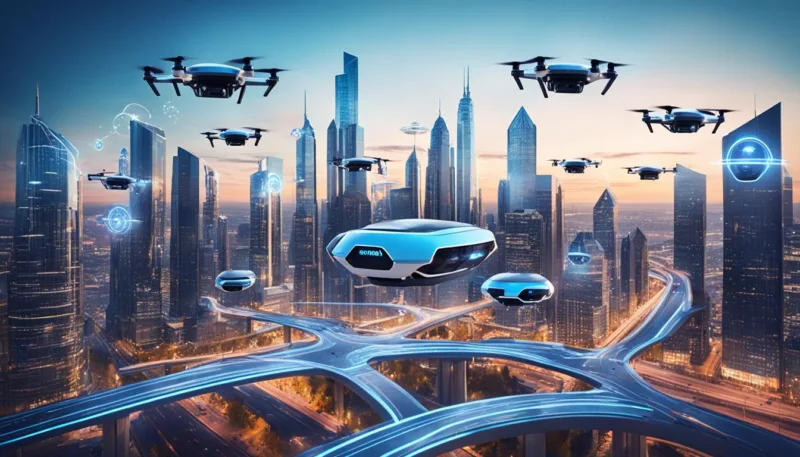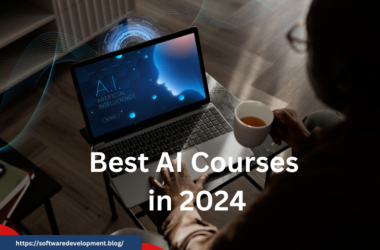Artificial Intelligence (AI) is now a major part of our daily lives. It’s changing many fields and making things we once thought impossible, possible. As we look towards 2024, there are exciting AI trends to watch. These include new tech improvements and breakthroughs in cognitive computing.
So, what’s hot in AI for 2024? Are there any trends or updates that might surprise us? We’ll dig into the most important trends. And we’ll see what amazing opportunities AI could bring us next.
Key Takeaways:
- Stay informed on the latest AI trends and industry updates to remain at the forefront of innovation.
- Prepare for the integration of AI into existing applications and the rise of generative AI assistants.
- Explore the potential of multimodal AI and its ability to process various data types.
- Consider the implications of AI agents and automation on streamlining processes and efficiency.
- Understand the importance of retrieval-augmented generation for accuracy in AI models.
AI Adoption and Integration with Existing Applications
Today, more businesses are using AI to improve their work. Instead of starting from zero, many are adding AI to the apps they already use. This approach helps them enjoy AI benefits without changing everything they have.
Integrating AI with what companies already have makes things more efficient. It brings AI benefits into familiar places, making work smoother and results better.
Copilots are a key example of AI in action. These AI helpers work alongside people, handling tasks from sorting information to creating new content. They help users make quality work quickly.
When we add AI to existing apps, amazing things happen. Businesses can think up new ideas, skip boring tasks, and make their users happier.
Big companies like Microsoft and Google have made their own AI copilots. Microsoft’s version works with Microsoft 365, helping people do more with their usual tools.
Google’s copilots help with special tasks, making it easier to work together and solve problems. These AI tools blend into what you’re already using, boosting creativity and teamwork.
Adding AI into apps we use every day does wonders. It sparks new ideas and helps businesses grow. With AI, companies can stand out, grow fast, and give more to their customers.
Mixing AI with what businesses already do is a big step forward. It changes how work is done, making things smoother and opening up chances for success.
Here’s a summary of AI adoption and integration with existing applications:
| Benefits | Examples |
|---|---|
| Enhanced productivity | Microsoft Copilot in the 365 suite |
| Improved user experience | Google copilots for specific tasks |
| Innovation and creativity | Integration of generative AI use cases |
| Streamlined processes | Seamless incorporation of AI within workflows |
By blending AI with current apps, companies can achieve new heights in productivity and creativity.
Multimodal AI and Innovation in 2024
In 2024, we’ll see a big focus on multimodal AI. It combines various types of data in AI models. This step forward will change how machines understand different data forms, like images and videos. It promises new opportunities for using AI in fields from healthcare to entertainment.
Create content beyond current data with generative AI models like GPT-4, Llama 3 and Stability AI. These models help businesses and groups make unique AI systems for their needs.
Examples of Multimodal AI in Action
Let’s look at some examples of multimodal AI at work:
-
Medical Diagnosis and Treatment
Multimodal AI helps doctors with accurate diagnoses and personalized plans by using images, records, and medical studies.
-
Intelligent Virtual Assistants
Think of an assistant that gets your voice commands and sees visual signals. This AI makes virtual helpers smarter and more sensitive to context.
-
Enhanced Customer Support
Businesses can offer better support by using AI that reads audio, text, and images. This improves customer happiness and loyalty.
Multimodal AI is leading to major improvements in how we process, analyze, and make decisions with data. AI’s ability to understand different data types will open new doors. It leads to a future where machines and humans interact more smartly and naturally.
AI Agents and Automation
The AI field is growing fast, and AI agents are at the front of this change in 2024. These agents can control other AI bots with just one instruction in natural language. This makes processes smooth and automated, changing how businesses and industries work.
Sachin Katti of Intel is a key person in developing AI agents. He believes AI agents will do jobs that whole departments do now. This will change how companies work and manage tasks.
AI agents make work faster and more efficient with less manual work. They work with other AI models, creating a connected AI system. This system quickly and correctly meets user needs.
AI agents have the potential to transform the way businesses operate by streamlining processes and automating tasks previously performed by humans or individual AI bots
Imagine telling an AI agent to do complex tasks without manual work. This lets businesses focus on strategic planning and solving problems creatively.
AI agents aren’t just for one industry. They can do various jobs like customer service and data analysis. This frees up people to do tasks that need critical thinking and creativity.
Adding AI agents to current systems is exciting. It allows companies to use AI and improve productivity. This means doing more with less cost and sparking innovation.
Intel’s Vision for AI Agents
Intel is pushing for more use of AI agents. Sachin Katti at Intel sees big chances for AI to change automation.
Intel knows a lot about AI and is working hard to make powerful AI agents. By using Intel’s advanced tech, AI agents can achieve great automation in many areas.
As we enter the AI agent era, the future of automation is wide open. Intel and others are leading the way, making AI part of our daily life.
Retrieval-Augmented Generation for Accuracy
RAG stands out as a key approach in making enterprise AI more accurate. It lets large language models check their answers against outside info. This ensures the info they provide is trustworthy and lowers the chance of errors.
Two important factors, prompt engineering and fine-tuning, upgrade AI tasks. Prompt engineering designs clear instructions to help AI give correct answers. Fine-tuning boosts how well the model works by teaching it with specific data.
RAG, prompt engineering, and fine-tuning are critical for AI accuracy. They use external knowledge, improve prompts, and adjust models for specific tasks. This makes AI systems more reliable and precise, helping businesses make smarter choices.
Benefits of Retrieval-Augmented Generation and Fine-Tuning:
- Improved accuracy in AI models
- Reduced occurrence of false information
- Enhanced reliability of AI-generated responses
- Customization of open models for specific tasks
- Optimization of AI performance through fine-tuning
Retrieval-augmented generation and fine-tuning techniques allow enterprises to unlock the full potential of AI by improving accuracy and tailoring AI models to their specific needs.
Real-World Applications
These techniques are used in many fields, like:
- Customer support: AI chatbots give better answers by using outside information.
- Medical research: Researchers get the latest medical info, leading to better patient care.
- Legal industry: AI gives reliable legal advice by finding and using legal info.
Thanks to RAG, prompt engineering, and fine-tuning, enterprise AI is becoming more accurate and effective. These methods allow organizations to fully use AI for innovation, improving operations, and making sure decisions are based on solid data.
AI and Sustainability Concerns
AI technology has grown fast, helping many industries. But, it also brings sustainability worries. Energy and resource use of AI models is a big concern when compared to old computing ways.
AI needs a lot of electricity and water. This makes energy use go up. It may harm the environment. It makes us think about how much energy AI uses and if our grid can handle it.
NVIDIA and Microsoft are tackling these issues. They’re making AI data centers use less energy. They aim to cut down on carbon emissions and use green energy for AI.
NVIDIA is working on AI chips that use less power but work great. They want to make AI better for our planet. They don’t want to lose any performance.
Microsoft is also working on green AI data centers. They use renewable energy and cool tech to lessen AI’s environmental impact.
NVIDIA and Microsoft are leading the way to a greener AI future. They innovate and work together. They show the industry how to be sustainable with AI.
Sustainability is a must for AI companies. By using less energy, cutting carbon, and using renewable energy, AI can be good for our planet. – NVIDIA CEO, Jensen Huang
Sustainable Practices in AI Data Centers
To lessen AI’s environmental impact, firms are going green in their data centers. They do things like:
- Use energy-saving hardware and cooling to cut energy use.
- Use virtual tech to better use resources and lower carbon emissions.
- Use smart power systems to watch and manage energy use.
- Look into using solar and wind energy for AI.
These green moves help companies use less energy and emit fewer greenhouse gases. They’re aiming for a sustainable AI future.
Shift in Roles for AI Specialists
The role of AI specialists is changing due to more generative AI in businesses. In 2023, prompt engineering became a key skill. Prompt engineers taught AI models, like ChatGPT, how to respond. But, as generative AI grows, software engineers might start doing this work instead of just AI specialists.
Companies now see the need for an overall AI plan. They are changing AI roles. Rather than just having AI specialists, they are creating teams with AI and data and analytics officers. These teams are led by tech leaders like chief AI officers.
The Shifting Landscape of AI Roles
How companies assign AI roles can differ. Some might keep special AI specialists for jobs like prompt engineering. Others might let software teams handle AI tasks.
The demand for AI specialists with prompt engineering skills was significant in 2023. However, as generative AI becomes more mainstream, it is reasonable to expect that prompt engineering could become a regular task for software engineers.
This change shows how AI is becoming a bigger part of many fields. By making AI a part of software engineers’ jobs, companies can work more smoothly. They can also mix different teams’ skills, leading to new ideas.
| Traditional Roles | Evolution of AI Roles |
|---|---|
| AI Specialists | Software Engineers with AI Expertise |
| Specialized AI Tasks | Integrated AI Responsibilities |
| Dedicated AI Teams | Collaborative AI Integration |
Even with these changes, some companies still need expert AI people. They work on big AI projects or solve specific problems. Data and analytics officers also play a big role. They make sure AI plans fit with the company’s bigger goals.
The way AI jobs are changing shows AI is becoming normal in companies. Joining tech skill with AI knowledge is key to innovation. It helps create lasting AI strategies.
AI in the Art World
AI has changed the art scene a lot. It lets artists make and connect with their work in new ways. Adobe Stock uses AI to help artists find new methods and ideas.
Platforms like Shutterstock and NVIDIA have introduced 3D image tools. These tools help artists create amazing 3D art. It opens up new possibilities beyond traditional art.
AI art brings up issues like wrong attribution and theft. Knowing if art is made by AI is key to giving credit correctly. The art community is still figuring out how to manage these challenges.
OpenAI’s Sora is a big deal in the art world. It was made for filmmakers but now impacts many artists. People are still talking about what it means for art.
| AI Art Platforms | Features |
|---|---|
| Adobe Stock | AI art creation capabilities |
| Shutterstock | 3D image generation tools |
| NVIDIA | Advanced 3D image generation |
AI brings both chances and trials for artists and fans. As AI grows, it will be interesting to see its role in art’s future.
Realistic Expectations for Generative AI
Generative AI is making waves in the business world. Leaders are now getting the picture of what it can do. They see that integrating it into existing services is where the real power lies, not just in standalone tools like ChatGPT.
The Gartner Hype Cycle and Deloitte’s report highlight how generative AI adoption is unfolding. Businesses see the value in weaving it into their current operations. This approach boosts human abilities and can change industries.
More companies can now use generative AI thanks to easier access and lower costs. This change is a big deal for everyone, from small startups to big global companies. It helps improve work, spark new ideas, and make customers happier.
Putting generative AI into everyday business tools is a major reason it’s becoming widespread. It makes software smarter, tasks simpler, and insights deeper. This leads to more success, growth, and edge over competition.
Transforming Industries with Integrated Generative AI
Generative AI’s power to craft content, visuals, and code is changing many fields. Here are some examples:
| Industry | Application |
|---|---|
| Marketing | Automating content generation for social media campaigns, personalized email marketing, and chatbot interactions. |
| Fashion | Designing unique clothing patterns and styles, generating personalized recommendations based on consumer preferences. |
| Healthcare | Assisting in medical diagnosis, predicting patient outcomes, and automating medical report generation. |
By integrating generative AI, industries make their processes smoother. They also open doors to new ways of innovating and serving customers.
Leaders know that realistic goals for generative AI mean blending it with their current services. As its use grows, staying up-to-date with its advancements is key for any organization.
Small Language Models and Performance
Small language models (SLMs) are gaining popularity in AI. They are smaller, affordable, and often perform well. Unlike bigger models needing lots of resources, SLMs like Phi and Orca excel with the right data.
SLMs make AI more accessible to everyone. They need fewer resources, allowing many users to tap into AI. This opens AI’s benefits to more individuals, businesses, and organizations.
Developing models like Phi and Orca pushes innovation in AI. Researchers use new methods to make these models better, leading to AI breakthroughs.
The Future of Small Language Models
SLMs are making AI research and development easier. They encourage more experimentation and innovation. This teamwork will improve AI over time.
As SLMs become popular, we’ll see models for specific needs. They’ll offer better performance for various applications and industries.

Small language models mark a big step forward in AI. They bring better access, affordability, and performance. With ongoing research, SLMs will keep shaping AI’s future.
Multimodal AI and Real-World Applications
Multimodal AI is changing how we use technology by handling different kinds of data like text, images, audio, and video. It analyzes all sorts of information together. This leads to better user experiences and results.
Take Microsoft Copilot as an example. It’s a tool that uses multimodal AI to work with images, language, and search info. By using varied data, Microsoft Copilot gives useful information. It helps users complete tasks more efficiently.
Microsoft Designer is also making waves with multimodal AI. It mixes text, images, and other data to let users make cool content easily. It also uses custom neural voices. This makes talking to AI feel more real and natural.
Multimodal AI is great at handling lots of different data. It’s creating new chances in communication, art, and solving problems. As this tech gets better, we’ll see even cooler uses. These advances will make our lives better in many ways.
Conclusion
The year 2024 is shaping up to be thrilling for AI, with lots of new trends. We will see AI merge more with current apps, the growth of multimodal AI, and a big push for eco-friendliness. These changes will steer the direction of tech. To keep up and stay ahead, companies must follow these AI developments closely.
AI is set to make big changes in many areas. It’s going to change how things work, make user experiences better, and tackle tough problems. Keeping up with AI news is key to making the most of what AI offers.
For businesses, catching on to AI trends is vital for doing well in this digital age. Using AI can help companies be more competitive, improve how they work, and find new chances for growth. The future of AI looks promising. Staying updated on tech trends will help in driving innovation and using AI’s potential fully.






